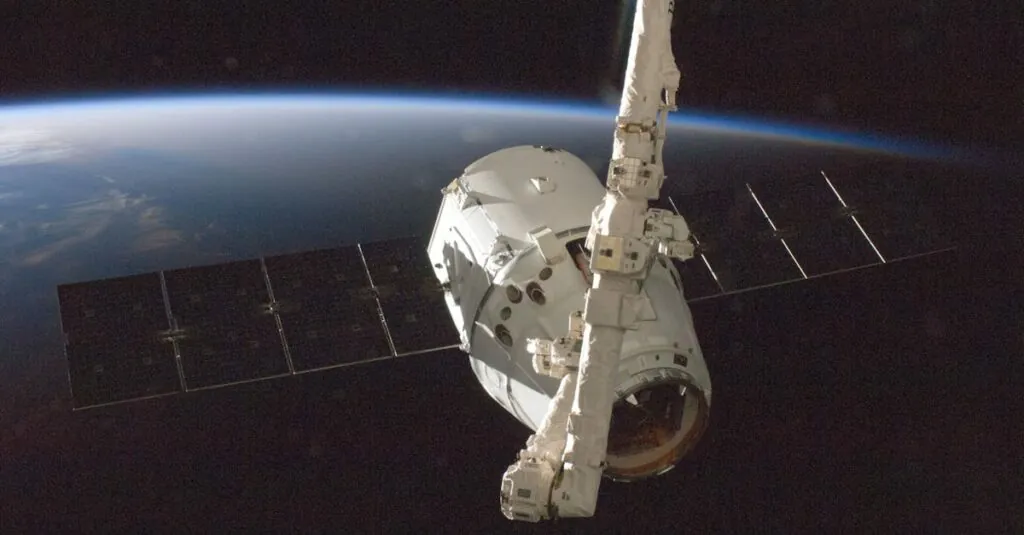Table of Contents
ToggleSpace technology isn’t just for astronauts and sci-fi enthusiasts anymore. It’s the backbone of modern innovation, influencing everything from GPS on your smartphone to weather forecasting. Imagine a world where satellites are your best friends, helping you navigate life’s challenges—like avoiding traffic on your morning commute or predicting when to grab an umbrella.
What Is Space Technology?
Space technology encompasses a wide range of scientific and engineering disciplines focused on developing tools and systems for exploring, understanding, and utilizing outer space. This branch of technology plays a vital role in advancing human knowledge about the universe and enhancing life on Earth.
Satellites exemplify one of the most prominent applications of space technology. These objects orbit Earth and facilitate various services, like telecommunications, weather monitoring, and navigation. They collect data that informs critical decisions in agriculture, disaster management, and urban planning.
Rockets and spacecraft also represent significant components of space technology. Rockets propel vehicles beyond Earth’s atmosphere, while spacecraft transport humans and instruments to conduct research. The design and engineering of both adhere to strict safety and performance standards, ensuring successful missions.
Robotics finds its place within space technology as well. Rovers and landers explore celestial bodies, gathering data that expands scientific understanding. Examples, such as the Mars rovers, demonstrate the capability of robotics in performing complex tasks remotely in harsh environments.
Furthermore, advancements in materials science and communication technologies stem from space-related research. Innovations in lightweight materials lead to stronger, more efficient spacecraft, while enhanced communication systems improve the exchange of data between Earth and space missions.
Space technology represents a fusion of various disciplines designed to push the boundaries of exploration and innovation. Its applications extend beyond space exploration, influencing everyday life through improved communications, environmental monitoring, and much more.
Key Components of Space Technology
Space technology consists of essential elements that enable the exploration and utilization of outer space.
Satellites
Satellites play a vital role in modern space technology. They facilitate global communications through broadcasting and internet services. Weather satellites monitor atmospheric conditions, providing crucial data for forecasting. Navigation satellites offer precise positioning for GPS systems, enhancing travel efficiency. Research satellites gather important scientific information about Earth’s environment and outer celestial bodies. Each of these functions contributes significantly to daily life, aiding in agriculture, disaster response, and natural resource management.
Spacecraft
Spacecraft come in various forms, including crewed and uncrewed vehicles. Crewed spacecraft transport astronauts into space for missions on the International Space Station or deep space exploration. Uncrewed spacecraft, such as probes and landers, are designed to collect data from planets and moons. Innovative technology ensures safety and reliability during launches and landings. Each spacecraft’s design incorporates advanced materials and engineering principles to withstand the extreme conditions of space travel. These vehicles enable significant advancements in scientific knowledge and exploration.
Launch Vehicles
Launch vehicles, or rockets, are essential for sending payloads into orbit. They vary in size and capability, from small satellite launchers to heavy-lift rockets for large missions. Each launch vehicle operates using multiple stages, maximizing payload capacity and efficiency. Technological advancements in propulsion systems enhance performance and reduce costs. Reliable launch vehicles facilitate not only satellite deployment but also crewed missions to space. Overall, these rockets serve as the backbone of space exploration efforts.
Applications of Space Technology
Space technology plays a vital role across various sectors, showcasing its versatility and importance in modern society.
Communication
Satellites enhance global communication by facilitating phone calls, internet access, and television broadcasts. They enable faster data transmission over long distances, connecting people and businesses. Communication satellites orbit Earth, providing coverage to remote areas often lacking terrestrial infrastructure. This technology supports emergency response efforts by allowing seamless coordination during disasters. Innovations in satellite technology, including higher bandwidth and lower latency, directly benefit industries like telecommunications and media distribution.
Earth Observation
Earth observation satellites monitor environmental changes, providing crucial data for weather forecasting and climate monitoring. These satellites capture images of Earth, allowing scientists to track natural disasters, deforestation, and urban sprawl. Real-time data from these observations assists in effective resource management and agricultural practices, ensuring food security. Additionally, Earth observation technology contributes to pollution tracking and monitoring biodiversity, informing policy decisions aimed at sustaining the planet’s health.
Space Exploration
Space exploration relies on advanced spacecraft designed for various missions beyond Earth’s atmosphere. Robotic probes gather data on planets, asteroids, and comets, expanding our understanding of the solar system. Crewed missions, such as those to the International Space Station, enhance human knowledge of microgravity’s effects on biology. Innovations in propulsion systems continue to push the boundaries of exploration, enabling missions to Mars and beyond. Collaborative international efforts in space exploration foster scientific cooperation and inspire future generations.
Challenges in Space Technology
Space technology faces numerous challenges that hinder progress and implementation. These obstacles range from technical difficulties to economic limitations, each impacting advancements and exploration.
Technical Challenges
Technical challenges significantly affect the development of space technology. Complex engineering requirements arise when designing and building spacecraft capable of withstanding harsh space conditions. Environmental factors, such as radiation and extreme temperatures, affect equipment reliability. Additionally, the integration of various systems—propulsion, communication, and guidance—sometimes leads to unforeseen complications. Ensuring safety for crewed missions demands rigorous testing and high reliability, which can stretch resources. Rapid advancements in technology also pose a challenge, as staying ahead of innovations is crucial for competitive success.
Economic Constraints
Economic constraints hamper the progress of space technology initiatives. High costs associated with research, development, and launch operations limit funding opportunities. Engaging stakeholders often requires significant financial investments, which can deter potential partnerships. Budget cuts within governmental space agencies lead to project cancellations or delays, directly impacting mission timelines. Moreover, private companies face pressure to deliver profitable results quickly, sometimes compromising long-term research goals. Finding sustainable financial models remains a critical challenge as the demand for advanced space capabilities continues to grow.
Future of Space Technology
Innovations in space technology continue to evolve rapidly, shaping the future of exploration and applications in various fields. Increased collaboration between government agencies and private enterprises fosters new advancements, expanding capabilities in launching vehicles and satellite design. Enhanced rocket technology enables cost-effective access to space, attracting investments and encouraging ambitious projects.
AI integration plays a crucial role in streamlining tasks related to spacecraft navigation and data analysis. Robotics advancements promise to improve the efficiency and safety of missions beyond Earth, allowing for autonomous operation on celestial bodies. A focus on sustainable technologies ensures long-term viability, minimizing space debris and preserving the environment.
The advent of asteroid mining presents opportunities for obtaining rare materials and resources essential for future missions. Space tourism emerges as a burgeoning sector, appealing to commercial interests and expanding public engagement in space exploration. Ongoing development of habitats for humans on the Moon and Mars illustrates a commitment to interplanetary living and research.
Collaborative international efforts pave the way for expanded scientific discoveries and joint missions. This synergy fosters a spirit of cooperation, enhancing the global perspective on space exploration. Education initiatives aimed at inspiring the next generation of scientists and engineers will contribute to the ongoing growth of this field.
Investment in satellite technology enhances communication capabilities and climate monitoring efforts, addressing global issues like climate change. As nations recognize the benefits of space technology, new policies and funding opportunities emerge to support research and development, driving further progress.
The trajectory of space technology points toward a future rich with possibilities, significantly impacting industries and daily life.
Space technology is a dynamic field that continues to shape the world in profound ways. Its applications span from everyday conveniences like GPS and weather forecasting to groundbreaking advancements in exploration and communication. As innovations emerge and collaborations strengthen, the potential for space technology to address global challenges becomes increasingly evident.
The future promises exciting developments in sustainable practices and new industries, such as asteroid mining and space tourism. While challenges remain, the commitment to pushing boundaries and inspiring future generations ensures that space technology will remain at the forefront of human achievement. Embracing these advancements will undoubtedly lead to a more connected and informed society.







